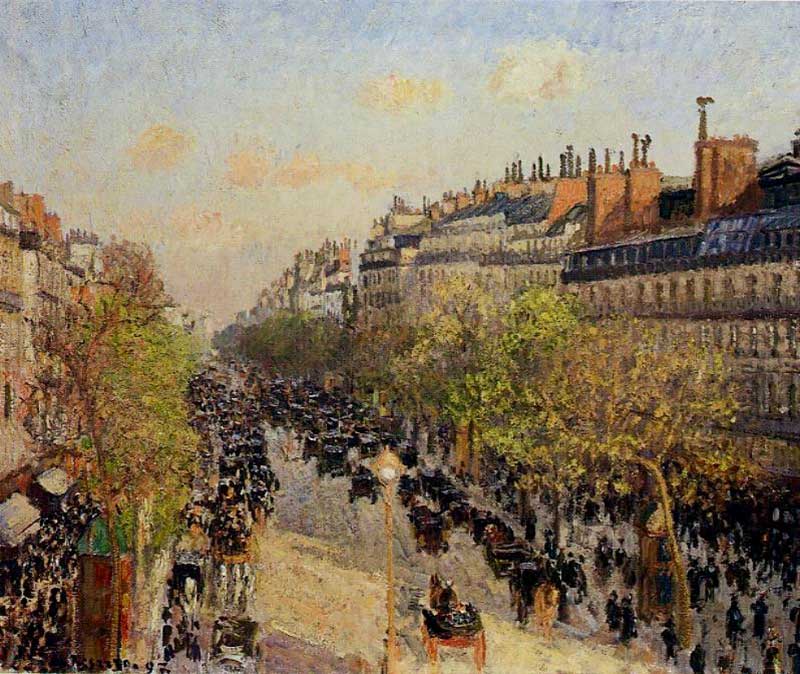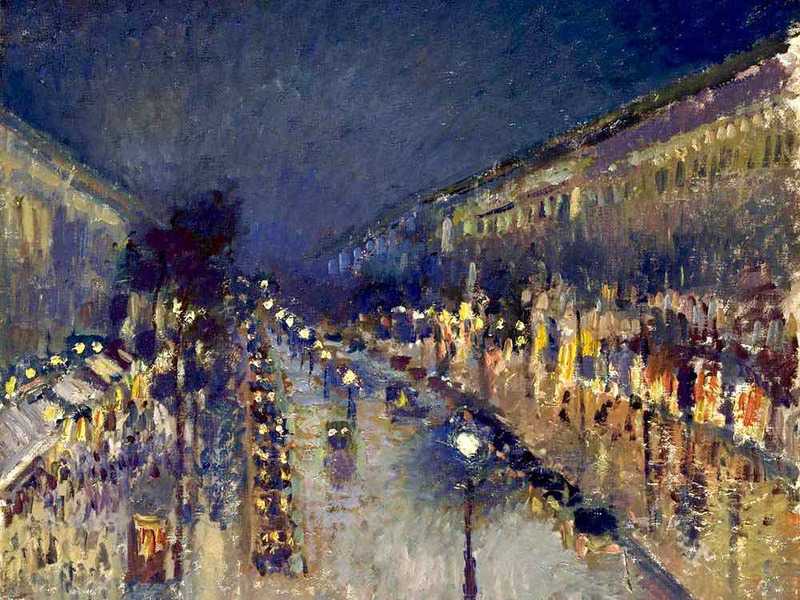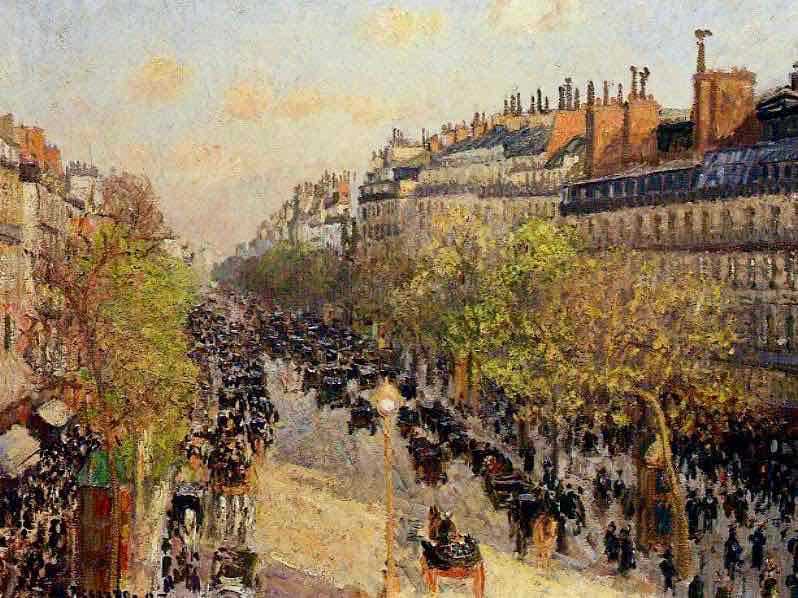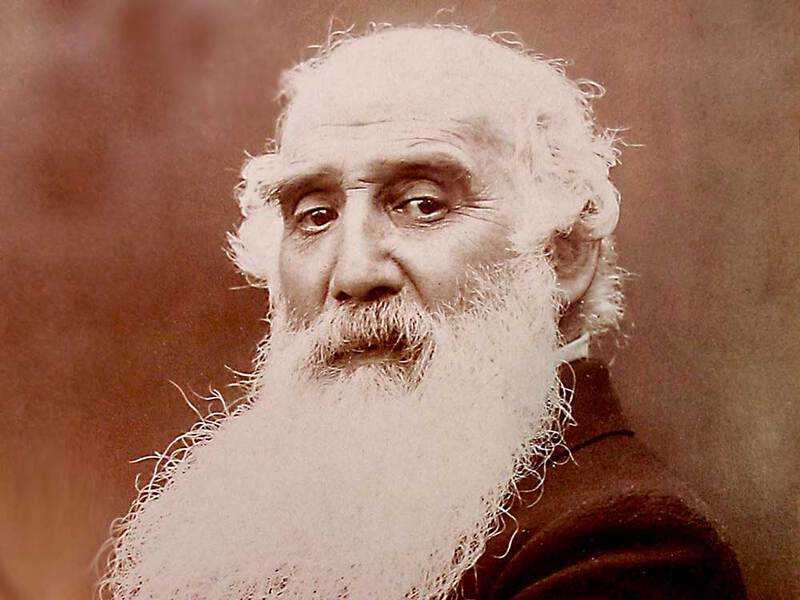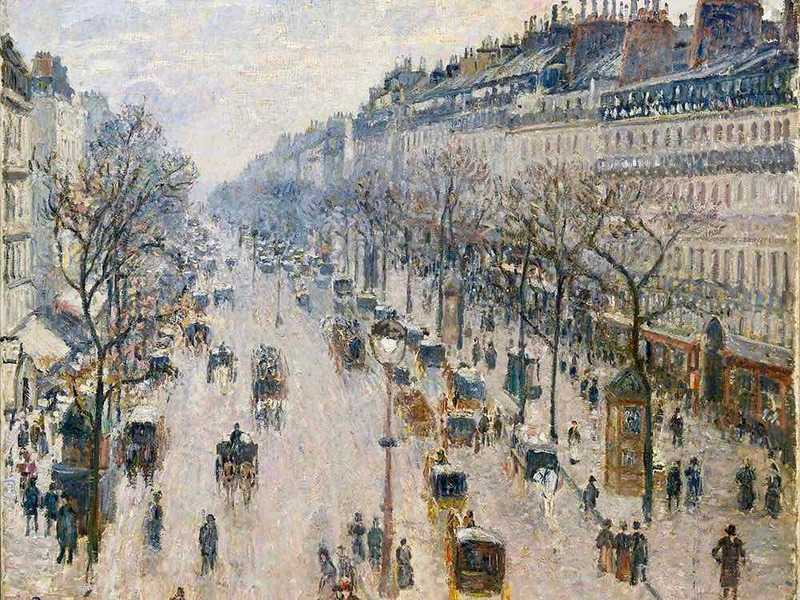1. The 14 Paintings
The 14 members of the Boulevard Montmartre series were painted between February and April 1897.
We have tracked down images of all 14 paintings, found below.
Those on public display
Painted in oil on canvas and typically measuring 65 x 81 cm (25.5 x 31.8 in), the seven members of the series found in museums are as follows:
- Boulevard Montmartre on a Winter Morning (The Met, New York).
- Boulevard Montmartre at Night (The National Gallery, London).
- Boulevard Montmartre, Afternoon Sunshine (The Hermitage Museum, St Petersburg)
- Boulevard Montmartre, Mardi Gras (The Armand Hammer Museum, Los Angeles)
- Boulevard Montmartre, Mardi Gras on the Boulevards (Harvard Art Museums, MA, USA)
- Boulevard Montmartre, Morning, Cloudy Weather (National Gallery of Victoria, Australia)
- Boulevard Montmartre, Spring (Museum Langmatt, Switzerland)
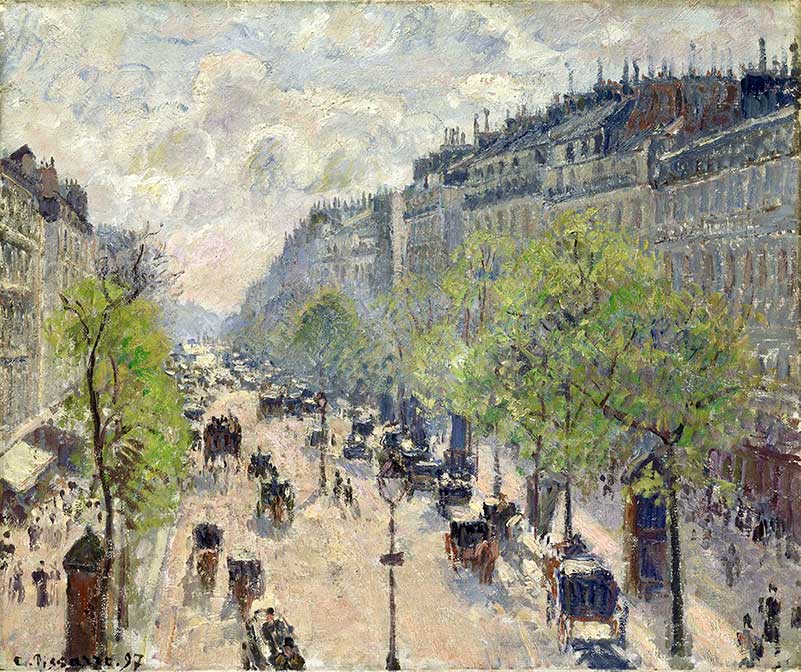
Private Collections
And the remaining paintings, held in private collections, are as follows:
- Boulevard Montmartre, Spring Rain.
- Boulevard Montmartre, Mardi Gras at Sunset.
- Boulevard Montmartre, Foggy Morning.
- Boulevard Montmartre, Sunset (or Boulevard Montmartre in the evening).
- Boulevard Montmartre, Spring Rain.
- Boulevard Montmartre, Sunlight and Mist.
- Boulevard Montmartre, Afternoon in the Rain.
Scroll down the page to see all 14 paintings, copies of which have been painstakingly located!
Analysis of the paintings shows that they were not produced in a single sitting, with Pissarro taking breaks when the weather and light changed and returning to and touching up the canvasses. Claude Monet adopted a very similar working practice when he painted pictures of London from his room in the Savoy Hotel.
The different paintings
What first strikes the viewer of Pissarro’s Boulevard Montmartre series is the variety among the different views.
In creating the series, Pissarro chose a highly systematic method of capturing the street scene in different conditions. This means that the part of the Boulevard captured in each painting is the same, but the weather, the trees and the activity of the people changes every time.
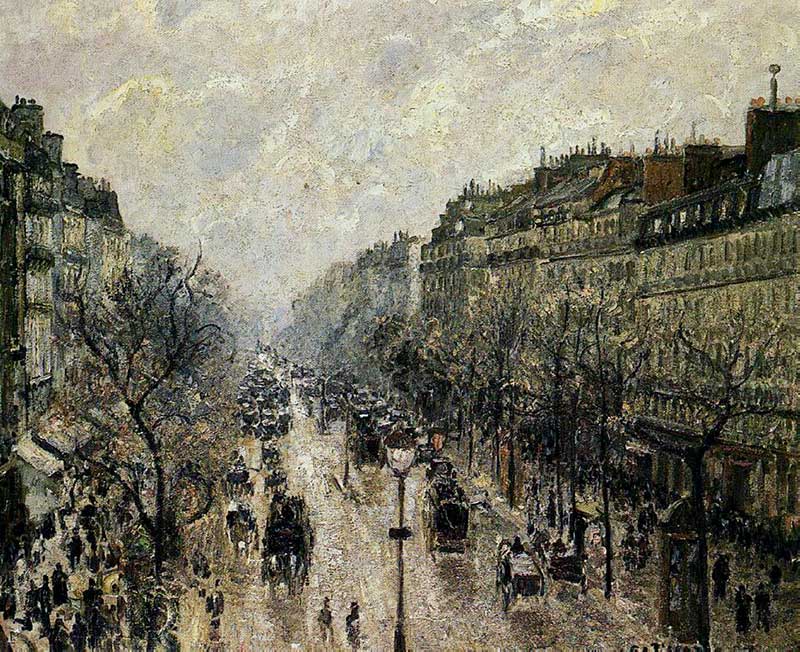
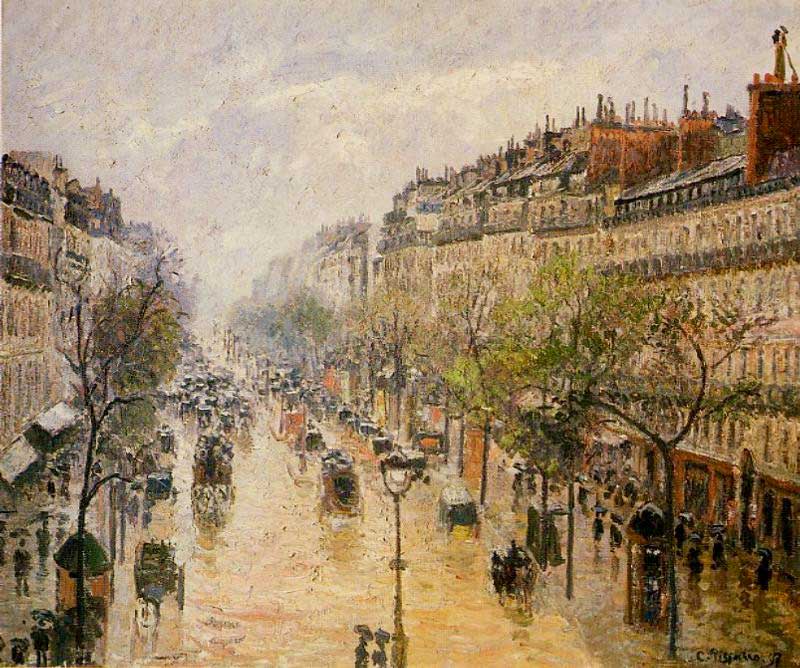
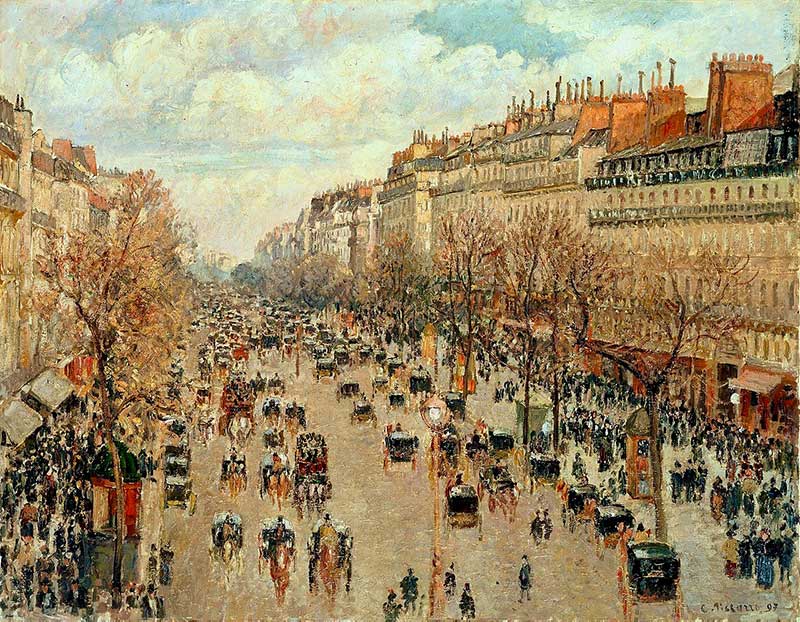
What results from this artistic device is a beautiful series of works that see the Boulevard bustling with activity in some works and at other times subdued in the rain or the cold.
As can be seen below, there is a view of the street during a festival and another set at night, with lamps lighting the street.
Pissarro's Approach
Pissarro approached the subject of his series with great care, explaining to his son Lucien:
“I have a splendid motif which I am going to explore under all possible effects, to my left; I have another motif which is terribly difficult, almost as the crow flies, looking over the carriages, buses and people milling about between the large trees and big houses which I have to set up right – it’s tricky… it goes without saying that I must solve it all the same.”
Though the works appear spontaneous and light-hearted, Pissarro studied his subject in extreme detail. He achieved the classic Impressionist effect through intense, industrious activity and focus.
The artist painted constantly for the two months he stayed in the hotel, working full days with one break of two and a half hours to give him time for lunch. He regularly worked on several paintings at once, moving between them as the light and atmosphere changed.
Boulevard Montmartre at Night
Pissarro’s synthesis of Neo-Impressionist and Impressionist styles can be seen in the only night scene from the series, entitled ’The Boulevard Montmartre at Night’.
In this painting, Pissarro experimented with capturing the effects of artificial light in paint. The work features a range of different light forms including electric street lamps as well as gaslights and oil-burning lamps.
Each of these light sources was painted in different ways to reflect the unique light they emitted. It has often been said that this is the first work of art depicting light pollution!
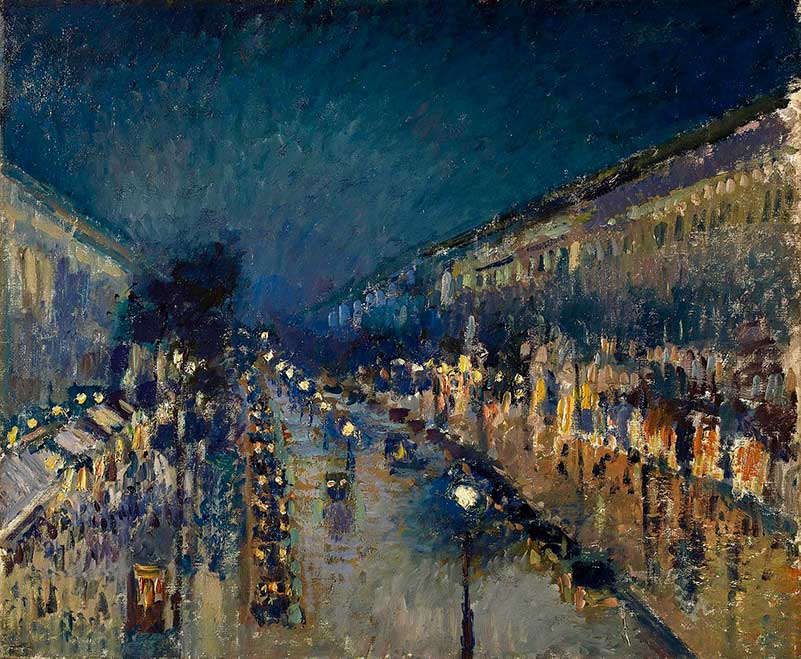
For the ‘electric candle’ arc lamp, used to light Paris’ streets from 1876, Pissarro used a thick brush and cool, white hues. He framed the street lamps with indigo blue to heighten the colour effects thrown out by the artificial light.
In contrast, he chose warmer hues for the gaslights in the shop windows, applying the paint in longer, freer brushstrokes. To depict the lamps on the cabs outside the Théâtre des Variétés, Pissarro built up the colour effect using a combination of red, white and yellow dots.
Mardi Gras
Three members of the series depict the Mardi Gras festival, resulting in a riotous combination of colour and varied brushstrokes.
For these pieces, Pissarro chose a view of the street during a festival with crowds thronging on both sides of the road. A parade can be seen marching in a column through the centre, painted as a series of dashes, daubs and dots in contrasting colours.
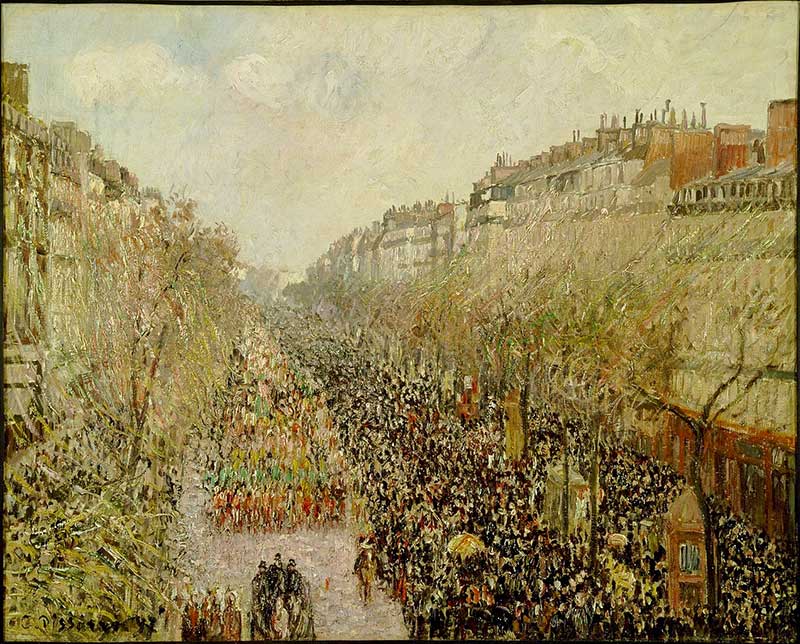
The spectators are a spotted array of colours intermixed with black. Meanwhile, the trees lining the street are a series of thin, wispy lines, painted in lyrical, expressive brushstrokes. The clouds in the sky offer another contrast, forming a soft mass of pale hues that make the dark mass of the people below stand out even more.
Throughout the Boulevard Montmartre series, Pissarro takes a casual approach to his observations of daily life. The figures appear to be placed at random, as though they are genuinely walking down the street and have been captured photographically. He grabs the natural rhythm of Paris and paints it into his canvasses.
It feels unstudied and at the same time is a perfect and exact depiction of ordinary life.
2. Background and inspiration
Up until 1897, Pissarro had largely painted outdoors in the countryside.
The Boulevard Montmartre series was accordingly unusual for him, being motivated by his failing eyesight and his need to make some money from his art.
Pissarro in the 1890s
Camille Pissarro was perhaps the strongest supporter of impressionism.
He often took artists under his wing, providing them with friendship and advice. Paul Cezanne and Vincent van Gogh are the most famous products of Pissarro's teaching methods. Pissarro was also the only artist to exhibit in all eight of the impressionist exhibitions.
But this support came at a price. Pissarro was not independently wealthy and had seven children to support. And, unlike Auguste Renoir, he refused to paint portraits of the wealthy Parisian elite to make good money.
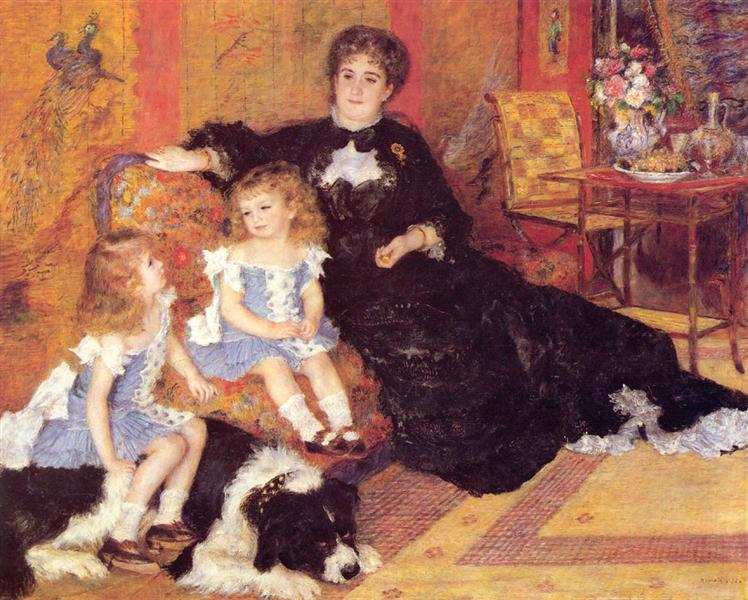
This meant that Pissarro remained poor in the early 1890s. He had dabbled with pointillism the previous decade, following the lead of Georges Seurat and Paul Signac. When explaining his decision to abandon pointillism, he said:
"It was impossible to be true to my sensations and consequently to render life and movement, impossible to be faithful to the effects, so random and so admirable, of nature, impossible to give an individual character to my drawing."
But the fact remained: Pissarro still had to make ends meet!
Monet's Haystacks and Rouen Cathedral
It seems very likely that the catalyst for Pissarro's decision to paint the Boulevard Montmartre series was the success of Monet's series of paintings of Haystacks and Rouen Cathedral.
- Monet painted 25 Haystacks between 1889-92. They achieved almost immediate commercial success, being sold by dealer Paul Durand-Ruel from his Paris gallery and dispersed around the world. Importantly, the Haystacks series showed the motif at different times of day and in different seasons.
- Monet's Rouen Cathedral series, painted between 1892-3, had many of the same characteristics. It was successful almost immediately, with the 30 members of the series also depicting the facade of Rouen's 12th century cathedral at different times of the day and year.
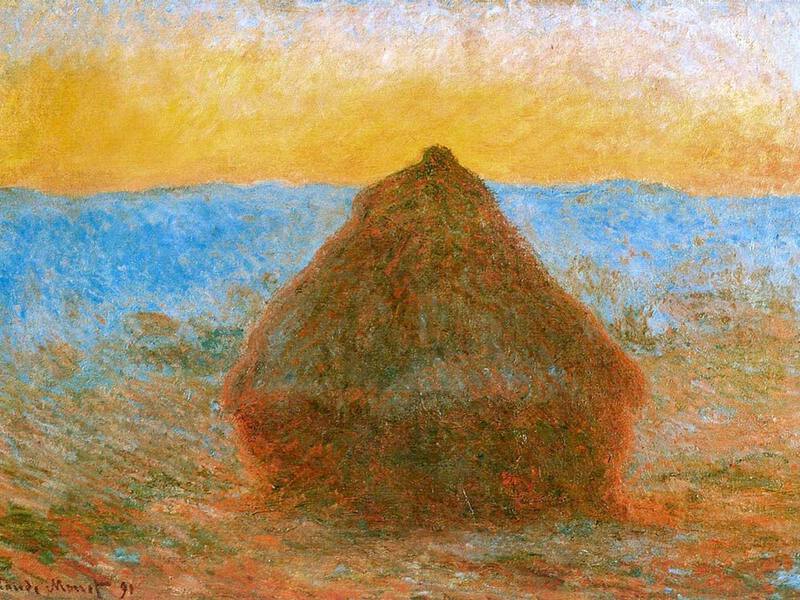
Inspiration
In 1872, Pissarro’s friend and fellow artist Ludovic Piette wrote to him saying:
“I have always loved the immense streets of Paris, shimmering in the sun, the crowds of all colours, those beautiful linear and aerial perspectives, those eccentric fashions, etc. But how to do it? To install oneself in the middle of the street is impossible in Paris.”
Evidently, the subject Piette wrote about also interested Pissarro. In 1897 he embarked upon a series of paintings as part of an attempt do just that.
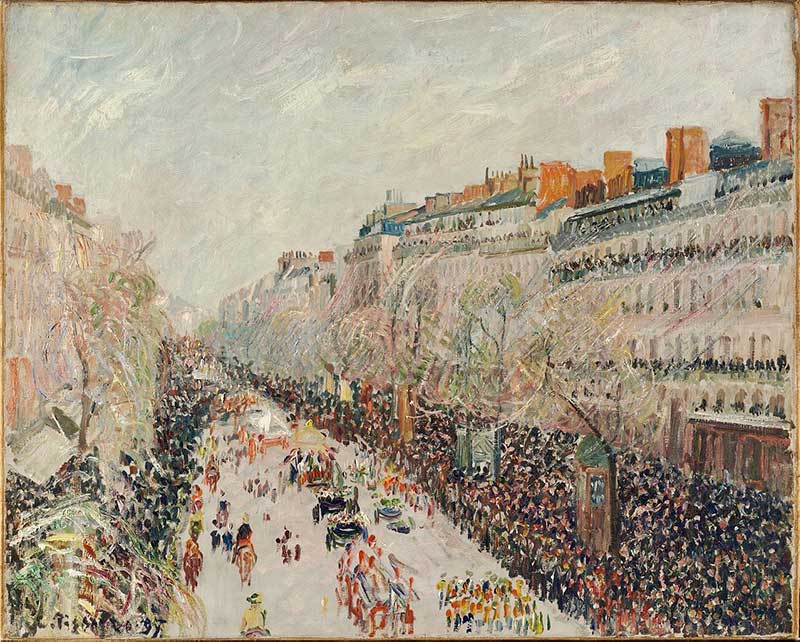
Pissarro solved Piette’s dilemma by choosing a position of elevation, placing himself above the throng in the streets. He painted the entire series from the window of a hotel situated high above the crowds.
3. Execution and Reviews
Painting the 14 canvasses from the Grand Hotel de Russie posed all sorts of challenges.
The Grand Hotel de Russie
From what can be gathered, the Grand Hotel de Russie was not (as its name might suggest) a five-star establishment. On the other hand, it was comfortable with an advertisement boasting that it offered a lift, bathrooms and electric lighting in all rooms!
The Grand Hotel was demolished in 1923, to make room for the construction of the last part of Boulevard Hausmann.
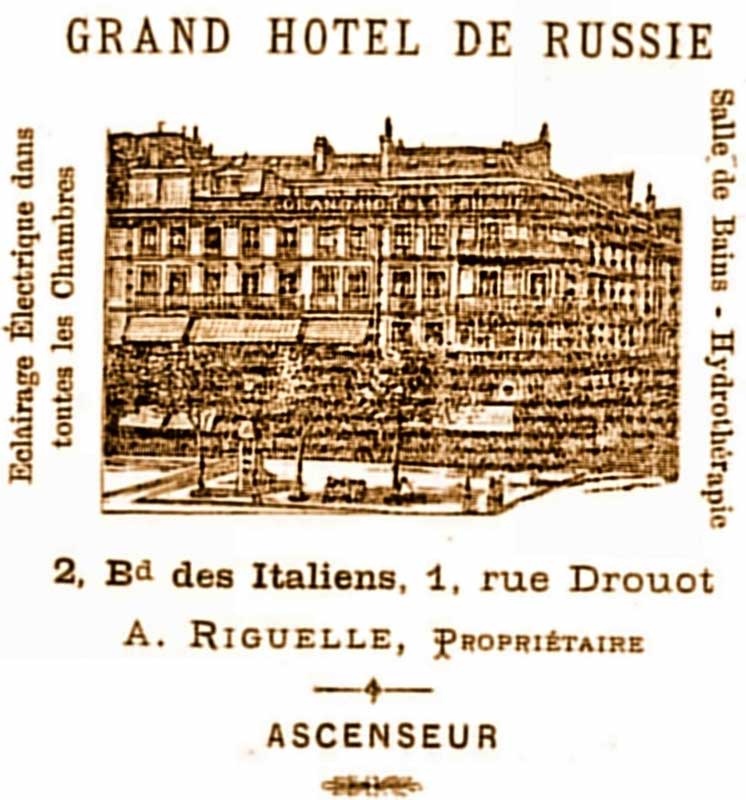
Perspective
The perspective of the series makes it feel as though the viewer is leaning out of the window to look into the street. We are immediately placed into the scene, mimicking Pissarro as we watch the people going about their lives. The series is a lesson in observation.

At this time, Pissarro was suffering from a debilitating eye condition that made it extremely uncomfortable for him to paint en plein air. By situating himself at his hotel window he was able to achieve the same effects of painting outside, in natural light, but also work without pain.
From this perspective, he was able to appreciate the subtle changes in the weather. Helpfully the window also offered an ideal framing device for his composition.
Technical Execution
As well as the subject matter, the Boulevard Montmartre series is also interesting for its technical execution. This series corresponds with Pissarro’s attempts to move from the Neo-Impressionist technique towards a looser and less restrained style.
One can get a sense of the stylistic questions that Pissarro struggled with when he wrote to his son, Lucien, in September 1888:
“How can one combine the purity and simplicity of the dot with the fullness, suppleness, liberty, spontaneity and freshness of sensation postulated by our impressionist art?”
The Boulevard Montmartre series can be seen as part of a larger move by Pissarro towards a greater appreciation for varied brushwork and texture. He gradually transitioned from Neo-Impressionism, creating his own style that incorporated both Impressionist and Neo-Impressionist styles.
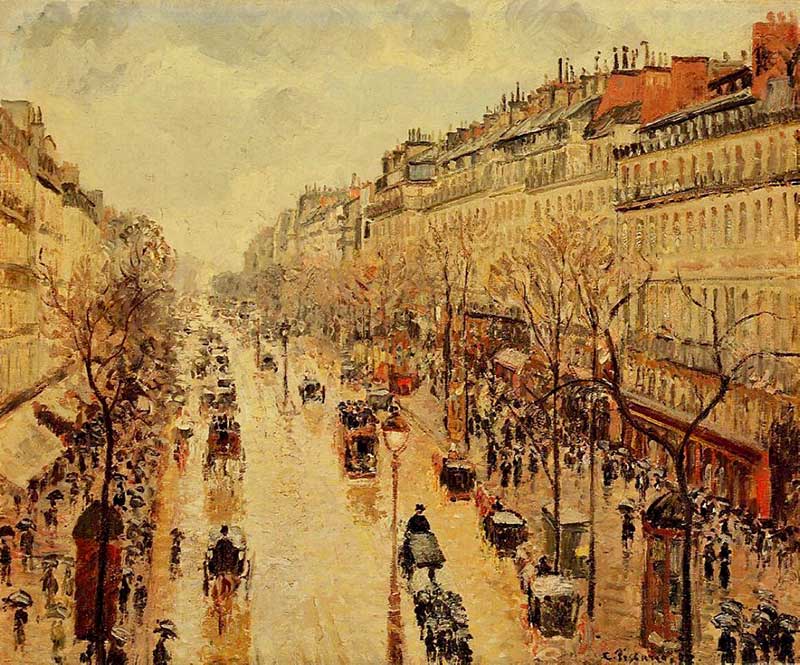
“Pissarro used the word “passage” to explain his latest technical experimentations”, described Karen Levitov in an exhibition catalogue for The Jewish Museum in New York.
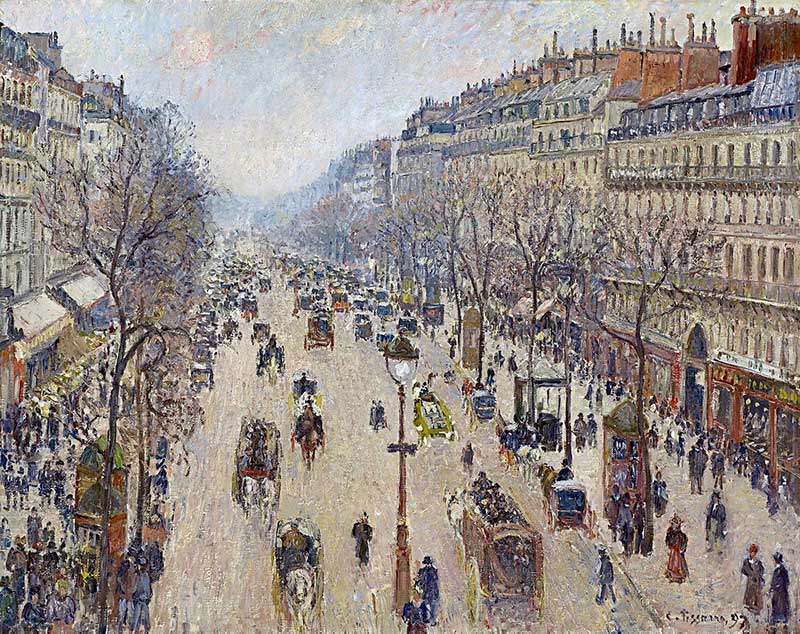
According to her analysis, the word “passage” can suggest “the modern transitions – in geographic location, artistic methodology, and political ideology – embodied by Pissarro’s pathways”. As the world around him changed, Pissarro sought out an artistic technique that could translate what he saw and transform it into art.
Reviews
Joachim Pissarro described the works as
“his most clearly focused series, as well as one of his most rapidly achieved, the Boulevard Montmartre series addresses elementary issues inherent in serial procedures. While representing a single motif seen under different combinations of light, weather and seasonal change, Pissarro’s approach to this series was capable of producing an infinite number of possibilities."
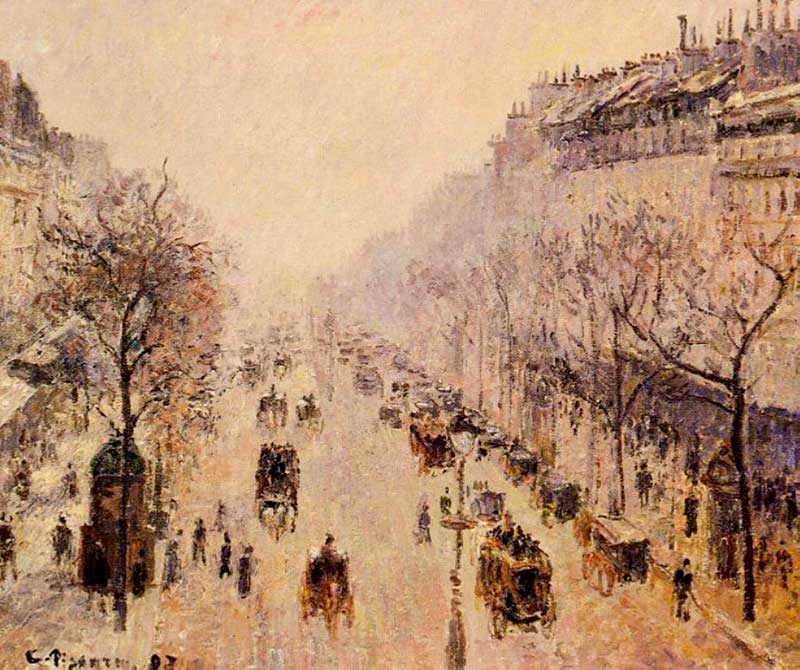
4. Buying and Selling
Since the time of painting, Pissarro’s Boulevard Montmartre series have been separated and sold off separately.
Each work has its own biography formed through numerous deals and changing of hands through the years.
Some of these individual stories form an interesting backdrop for looking at European history in the 19th and 20th centuries. For instance, ‘Le Boulevard de Montmartre, Matinée de Printemps’, a work depicting the street in spring as the first leaves are appearing on the trees, had a dramatic life.
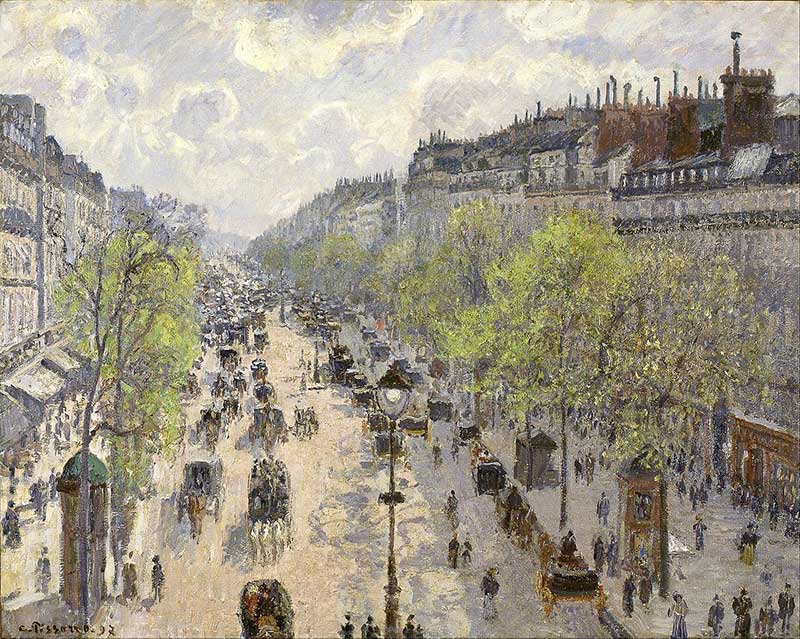
The life of a painting
The painting was first sold to impressionist dealer Paul Durand-Ruel on the 2nd June 1898.
It was purchased almost immediately by a private collector from London in 1899 before being bought back by Durand-Ruel two years later (Durand-Ruel often acquired the same work several times).
In 1902, the painting made its way to Germany under the ownership of Paul Cassirer and from 1923 it was in the collection of Max Silberberg. Silberberg was an industrialist from Breslau, Germany, now Wroclaw, Poland, who had started collecting impressionism, post-impressionism and realist works. (Silberberg’s collection is now regarded as having been one of the most impressive pre-war collections of 19th and 20th century art in Germany.)
Nazi war crimes
When the Nazis came to power in 1933, Silberberg, who was Jewish, quickly became a target of new anti-semitic laws.
He was forced to give up his public roles, his company was sold, and his house was handed over to the SS. Silberberg was further coerced into selling his entire art collection, which by this time was over 143 paintings. He and his wife were later sent to a concentration camp, where they are thought to have died around 1942.
Pissarro’s painting was held in a private collection for some years before being acquired by John and Frances L. Loeb, both ardent supporters of Jewish cultural organisations. They gifted the painting to the Israel Museum in Jerusalem in 1997.
Restoration and a Pissarro record
In 2000, Pissarro’s ‘Le Boulevard de Montmartre, Matinée de Printemps’ was restored to Silberberg’s remaining family by the museum and they allowed the work to remain on public display until the death of Silberberg’s heir. In February 2014, the painting was sold at Sotheby’s, where it fetched a price of £19,682,500 (which remains a world record for a Pissarro painting).
Closing words
The value of this piece is an indication of the status Pissarro’s art holds today. The street scenes offer an evocative glimpse into life in Haussmann’s Paris in the 19th century and the views of the Boulevard Montmarte are now considered to be the most innovative and masterful series in Pissarro’s oeuvre, especially among his urban landscapes.
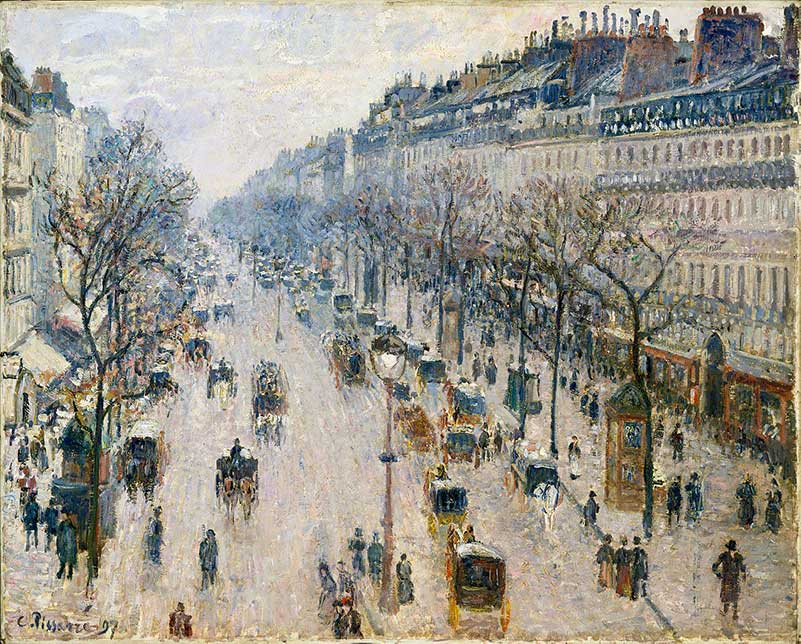
They are an indicator of Pissarro’s continual search for new subject matter and novel techniques. Throughout his career, he continued to experiment and push the boundaries of his art. He was unafraid to embrace different ideas and even in later life, he sought out young artists who were attempting to take French art beyond Impressionism, beyond Neo-Impressionism and to new heights.
